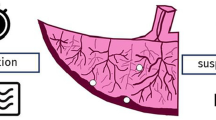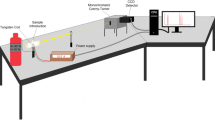Abstract
This work is an application of energy dispersive X-ray fluorescence (EDXRF) as an analytical technique for trace elemental determination in human membrane and placenta and elemental concentrations correlations in both tissues. Whole samples were collected during the delivery from healthy mothers and full-term pregnancies. The age of the mother was between 25 and 40 years old, and the weight of the infants ranged from 2.56 to 4.05 kg. Samples were lyophilised and analysed without any chemical treatment. No significant differences in elemental content of placenta and membrane samples were observed except for Ca. Very low levels of Se, As and Pb were observed in all the analysed samples. Zn, considered as one of the key elements in newborn health, was not significantly different in the analysed samples, all of which originated from healthy mothers and healthy babies. The obtained values agree with the literature except for Ca, which is much higher in the studied samples.


Similar content being viewed by others
References
Parizek J (1964) J Reprod Teratol 7:263
Weir PJ, Miller RK (1990) Trophoplast Res 2:357
Hurley LS (1977–1978) Nutritional deficiencies and excesses in teratogenesis. In: Wilson JG, Fraser FC (eds) Handbook of teratology, vol 1. Plenum Press, New York, p 261
Saner G, Yüksel M (1989) Int symposium on trace elements Paris, 1987. In: Chazot G, Abdulla M, Arnaud P (eds) Curr Trend Trace Elem Res. Smith Gordon and Comp, London, pp 70–73
Hunt IF, Murphy NJ, Cleaver MSAE, BahramFaraji MOH, Swendseid ME, Coulson AH, Clark VA, Browdy BL, Cabalum MT, Smith JC (1984) Am J Clinic Nutrition 40:509–521
Marsal Kand Furgyik S (1987) Acta Obstet Gynecol Scand 66:653–656
Scane TMN, Hawkins DF (1984) British J Obstet Gynecol 91:342–348
Laitinen R, Jalanko MH, Klho KL, von Koskull H, Vuori E (1985) Am J Obstet Gynecol 152:561–565
Liendo JA, Gonzalez AC, Castelli C, Gómez J, Jiménez J, Marco L, Sajo-Bohus L, Greaves ED, Fletcher NR, Bauman S (1999) X-Ray Spectrom 28:3–8
Manci EA, Blackburn WR (1987) Placenta 8:497–502
Goyer RA, Haust MD, Cherian MG (1992) Placenta 13:349–353
Van den Hamer CJA, Cornelisse C, Bol J, Vermeulen AMTI, Aalbers ThG (1989) Int symposium on trace elements Paris, 1987. In: Chazot G, Abdulla M, Arnaud P (eds) Current Trend Trace Elem Res. Smith Gordon and Comp. Limited, London, pp 34–36
Carvalho ML, Custódio PJ, Reus U, Prange A (2001) Spectrochim Acta B 56:2175
Carvalho ML, Brito J, Barreiros MA (1998) X-Ray Spectrom 27:198–204
Boman J, Selin E, Öblad M, (1988) Phys Scripta 37:274–278
Rindby A (1989) X-Ray Spectrom 18:113–118
Carvalho ML, Marques AF (2001) X-Ray Spectrom 30:397–402
Acknowledgements
The authors express their sincere gratitude to Garcia de Orta Hospital for providing the samples.
Author information
Authors and Affiliations
Corresponding author
Rights and permissions
About this article
Cite this article
Custódio, P.J., Carvalho, M.L. & Nunes, F. Trace elements determination by energy dispersive X-ray fluorescence (EDXRF) in human placenta and membrane: a comparative study. Anal Bioanal Chem 375, 1101–1106 (2003). https://doi.org/10.1007/s00216-003-1765-9
Received:
Revised:
Accepted:
Published:
Issue Date:
DOI: https://doi.org/10.1007/s00216-003-1765-9




